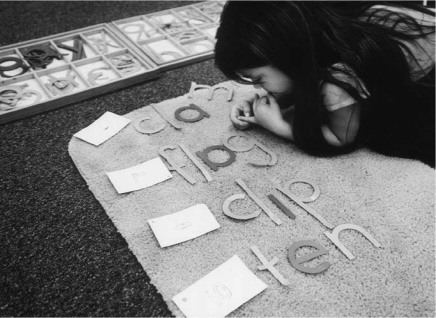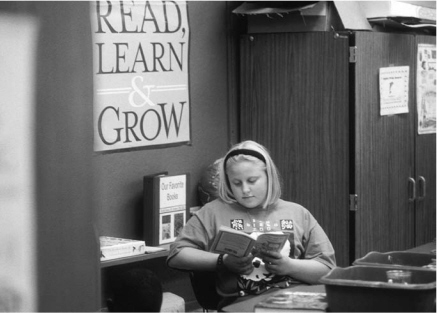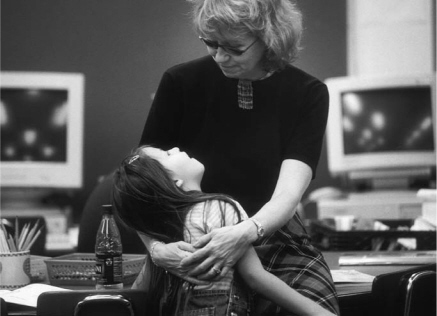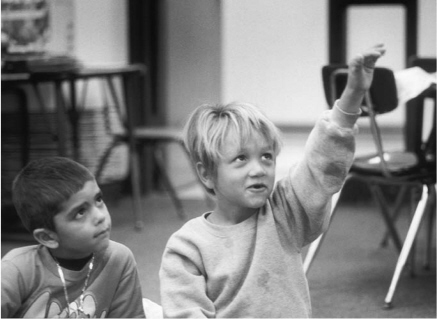Chicken Soup for the Soul Celebrates Teachers (4 page)
Read Chicken Soup for the Soul Celebrates Teachers Online
Authors: Jack Canfield


Driving to work the next day, I found myself anxious to see her reaction. Would she resent the move? Would she think this plan was stupid? Would it make matters worse? Now she had even
more
space to mess up.
The next morning she came in the room in a tizzy as usual, already fussing with a classmate. She spotted her new space almost immediately. She stopped and looked silently for what seemed like a long time. Quietly she asked, “Is this mine?”
“It's for your things if you feel like you need it,” I said nonchalantly, busying myself with papers on my desk.
“I like this card, Mrs. S.,” she said, holding it up and turning it over in her hands.
“Thank you,” I said. “It's for you. You can keep it.”
Clarissa began organizing her things. She opened the drawers and put things away. She opened the drawers again, taking the items out, rearranging and replacing them. She spent the next hour (forget the spelling, language and readingâthis time was that “teaching moment” you hear about in college) setting up her “nest.”

I knew the question would come from her classmates. Sure enough, within only a few minutes a student asked, “How come she gets that?” I had prepared myself for this question.
“Because she needs it. Would you like to offer to help her with her things?” I asked.
The student shrugged his shoulders, put his hands in his pockets, stood watching her for a few moments and walked back to his desk. No more was said. No one asked any more questions. No one seemed to resent it.
Clarissa spent the rest of the year keeping her things together in her space. That was nice. Peace was at hand in our classroom.
The real benefit of this arrangement came in a beautifully simple way. A beaten-up old filing cabinet and a small note card gave a gift to this child. She experienced a real sense of ownership. It gave her a sense of her special placeâa sort of haven from the difficulties of the day, the stresses of her school life and her family life.
I have since moved and lost contact with Clarissa. Wherever you are, my dear student, I would ask that you pass on this gift, the gift of creating a different path for someone to walk who might be struggling in some way. It will be the gift of giving someone a sense of ownership, her own space, his own note card.
And don't forget to add some flowers.
 Sandra H. Swindall
Sandra H. Swindall
T
om my Turtle had become a permanent part of my classroom during the years I taught preschool. I was never able to keep real pets alive, so I created Tommy. He was a small, green, squeaky turtle whose home had become a clear, plastic shoebox, complete with lid and plastic Easter grass. Each year, the children would take turns taking him home for the night. The children loved the thought of taking the class
pet
home with them! Since we didn't exactly explain the fact that he wasn't
real
before he was sent home, the parents always looked a bit frightened the first time their child carried Tommy's box to the door to go home. That was just part of the fun!
Although Tommy wasn't a
real
turtle, the children all treated him as if he were, and always took good care of him on his visits. The children would feed him dinner, take him for walks and tuck him into his bed at night. When Tommy returned to school with the children each day, he always came accompanied by crayon drawings and photos of his adventures.
Tommy did everything from riding on a four-wheeler to wading in a birdbath. He ate macaroni-and-cheese and Froot Loops for dinner. He watched movies and ate popcorn, and watched as the children brushed their teeth before bed each night. He was there when the children laughed; he was there when they cried. Each year Tommy would soon be returning to school with gifts from the children. Over the years, Tommy received several new blankets, and beautiful, sparkly rocks always decorated his plastic home. One year, he even had a small bowl of plastic lettuce to munch on when he was hungry, and a “pet” plastic fish to keep him company when he grew lonely. Every year, the children came to love Tommy, and every year, Tommy became a little more
real
.
While the children learned to take care of Tommy, I believe that Tommy took care of a lot of them, too. Several times the children did not have the words to tell me directly when something was wrong, but they were able to tell me through Tommy and his pictures. Even though I was not always able to know the exact reasons behind their behaviors, Tommy helped many of the children find the words to help me understand a little better.
The children's pictures of Tommy's visit to their homes helped me to see things I might not have known anything about. Sometimes, Tommy was kept awake all night by a crying baby. Sometimes, he went with a child to spend the night at a divorced parent's house. Sometimes, he went to bed late and didn't want to get up in the morning. The “Tommy Pictures” were not always just drawings of him walking in the grass; sometimes they were windows into the homes of my students. Those windows occasionally helped me to see much more than I ever would have without Tommy.
Tommy was made of plastic, and he talked with a squeak when you squeezed him, but he was real to all my preschoolers. He was real to me, too.
 R. Lynn Baker
R. Lynn Baker

T
hey wiggled on the floor around my feet signaling the end of the lesson.
“Now let's remember what we've learned today,” I said vying for one more moment of their attention in hopes of proving to myself that I had indeed gotten their attention at all.
Five-year-olds never cease to amaze me. Each afternoon I teach religion in the back of my classroom. Me in a chair, and them around me on the “quiet carpet.” They wriggle and wriggle, fidgeting and squirming as I read to them and pray to them. And do anything else I can think of to educate their minds and nourish their souls. At a glance, you would never guess they were even hearing me, let alone comprehending or “feeling” my objective. But after a few years of doing this, I have finally realized that through an occasional somersault they are hearing, understanding and even feeling.
“We talked about the different ways to pray,” I reminded them. “Who can tell me these ways?” I asked.
“Going to church!” someone shouted.
“Good,” I complimented.
“Saying prayers,” came another. I nodded.
“Singing hymns.”
“Doing good.”
“Reading the Bible.”
“Very good!” I all but squealed. “And why do we do all of these things?” I asked, my voice rising in anticipation.
If only they could answer this last question, I could stamp myself a success. I would know that I had actually taught them something. My stomach almost hurt with the wait.

“To learn about God,” came the reply.
I'd like to say it came from above, but to be completely honest, it came from below, very below. Actually, it came from inside a shirt that the responder had pulled up over his face. I was so relieved to get the answer that I was looking for that I didn't have the heart to scold him.
“Thank you, Brian,” I noted.
“You're welcome,” he mumbled still under his shirt.
I let myself smile and leaned back in my chair.
“You really were listening,” I beamed, satisfied. I sat there, basking in what I thought was the end of the lesson.
But God seemed to turn to a precocious brown-haired mop-top, gently laying a hand on his head and whispering “Listen” into his ear. The lesson was not over yet.
